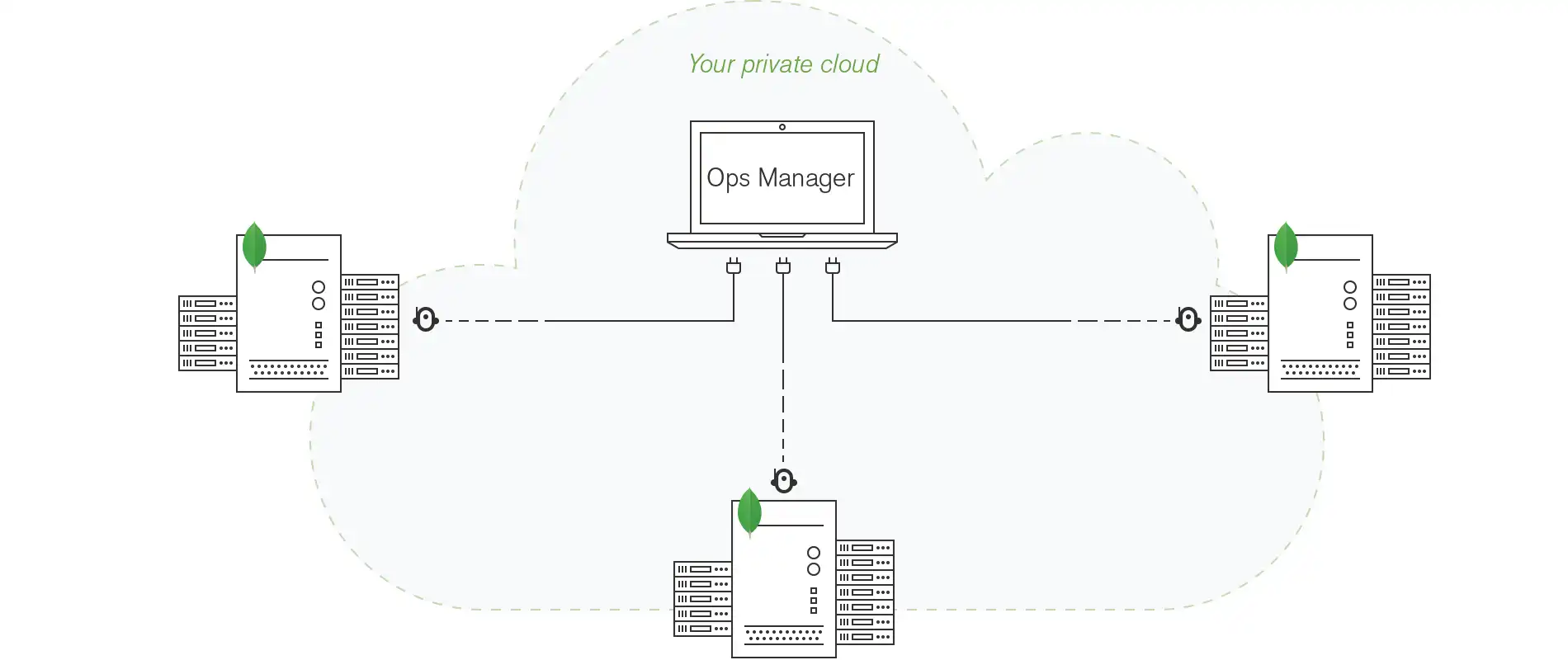MongoDB Ops Manager can automate, monitor, and back up your MongoDB infrastructure.
Automation
Ops Manager Automation enables you to configure and maintain MongoDB nodes and clusters.

MongoDB Agents using Automation on each MongoDB host can maintain your MongoDB deployments. You can install the MongoDB Agent. Automation can add hosts and deploy and upgrade new or existing clusters.
Monitoring
Ops Manager Monitoring provides real-time reporting, visualization, and alerting on key database and hardware indicators.
How Monitoring Works
When you activate Monitoring on a MongoDB host, Monitoring collects statistics from the nodes in your MongoDB deployment. The Agent transmits database statistics back to Ops Manager to report deployment status in real time. You can set alerts on indicators you choose.
Backup
Ops Manager Backup provides scheduled snapshots and point-in-time recovery of your MongoDB replica sets and sharded clusters.
How Backup Works
When you activate Backup for a MongoDB deployment, Backup takes snapshots of data from the MongoDB processes you have specified.
Note
Sharded clusters and replica sets are the only deployment types you can back up if your databases run MongoDB FCV 4.2 and earlier. To back up a standalone mongod process running MongoDB FCV 4.2 or earlier, you must convert it to a single-member replica set.
Backup Workflow
Backups rely upon the MongoDB version compatibility of your database.
For MongoDB 4.4, the FCV can be 4.2 or 4.4.
The backup process takes a snapshot of the data directory at its scheduled snapshot intervals.
This process copies the data files in a MongoDB deployment, sending them over the network via Ops Manager to your existing snapshot storage.
Your deployment can still handle read and write operations during the copying process.
With the new backup process, there are no longer initial syncs. As a
result of not having initial syncs, Ops Manager (using a mongod running
FCV 4.2) can support a wider array of customers such as those
heavily using renameCollection.
The MongoDB Agent uses WiredTiger's incremental backup cursor to capture the incremental changes.
The backup process works in this manner regardless of how snapshots are stored.
Backup uses a MongoDB instance version equal to or greater than the version of the replica set it backs up.
Backup takes and stores snapshots based on a user-defined snapshot retention policy. Sharded cluster snapshots temporarily stop the balancer. The snapshots then can insert a marker token into all shards and config servers in the cluster. Ops Manager takes a snapshot when the marker tokens appear in the snapshot data.
How much storage capacity you need depends on both the number of snapshots and the type of snapshot storage you choose. The following table outlines the differences in snapshot stores:
Snapshot Store | Description |
|---|---|
MongoDB blockstore | Only the differences between each successive snapshot are stored. Compression and block-level deduplication reduce the size of snapshot data. |
AWS S3-compatible storage bucket | Only the differences between each successive snapshot are stored. Compression and block-level deduplication reduce the size of snapshot data. |
S3-compatible storage bucket | Only the differences between each successive snapshot are stored. Compression and block-level deduplication reduce the size of snapshot data. |
All snapshots represent a full backup. Ops Manager can back up data as a full or incremental backup. Ops Manager requires a full backup:
For your first backup.
After a snapshot has been deleted.
If the blockstore block size has been changed.
Incremental backups reduce network transfer and storage costs.
To learn more about how to configure backups, see Backup Configuration Options.
Restore Data
Backup can restore data from a complete scheduled snapshot or from a selected point between snapshots.
You can restore sharded clusters and replica sets from selected points in time.
When you restore from a snapshot, Ops Manager reads directly from the snapshot storage. You can restore the snapshot:
To another cluster.
To download the snapshot files from an HTTPS link.
When you restore from a point in time, Ops Manager does the following:
Restores a full snapshot from the snapshot storage.
Applies stored oplogs until it reaches the specified point.
Delivers the snapshot and oplog updates using the same HTTPS mechanisms.
You can configure how much of the oplog you want to keep per backup. This affects the amount of time a point-in-time restore can cover.